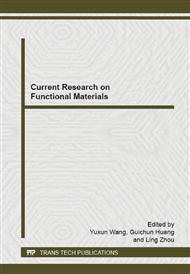[1]
Y. Yokoyama, Fulgides for memories and switches, Chem. Rev., 100 (2000) 1717-1739.
Google Scholar
[2]
S. M. Reduwan Billah, R. M. Christie and R. Shamey, Direct coloration of textiles with photochromic dyes. Part 1: Application of spiroindolinonaphthoxazines as disperse dyes to polyester, nylon and acrylic fabrics, Color. Technol., 124 (2008).
DOI: 10.1111/j.1478-4408.2008.00145.x
Google Scholar
[3]
S. J. Lee, Y. A. Son, H. J. Suh, D. N. Lee, S. H. Kim, Preliminary exhaustion studies of spiroxazine dyes on polyamide fibers and their photochromic properties, Dyes and Pigments, 69 (2006) 18-21.
DOI: 10.1016/j.dyepig.2005.02.019
Google Scholar
[4]
X. Chen, N. I. Islamova, S. P. Garcia, J. A. DiGirolamo, and W. J. Lees, Synthesis and optical properties of aqueous soluble indolylfulgimides, J. Org. Chem., 74 (2009), 6777-6783.
DOI: 10.1021/jo900909d
Google Scholar
[5]
N. I. Islamova, X. Chen, J. A. DiGirolamo, Y. Silva, W. J. Lees, Thermal Stability and photochromic properties of a fluorinated indoylfulgimide in a protic and aprotic solvent, Journal of Photochemistry an Photobiology A: Chemistry, 199 (2008).
DOI: 10.1016/j.jphotochem.2008.05.007
Google Scholar
[6]
Y. C. Liang, A. S. Dvornikov, and P. M. Rentzepis, Synthesis and Properties of Photochromic Fluorescing 2-Indolyl Fulgide and Fulgimide Copolymers, Macromolecules, 35 (2002) 9377-9382.
DOI: 10.1021/ma020750o
Google Scholar
[7]
M. W. Berns, T. Krasieva, C. H. Sun, A. Dvornikov, A polarity dependent fluorescence 'switch', in live cells, Journal of Photochemistry and Photobiology B: Biology, 75 (2004) 51–56.
DOI: 10.1016/j.jphotobiol.2004.05.002
Google Scholar
[8]
R. Matsushima, H. Sakaguchi, Comparison of the photochromic Properties of fulgides and fulgimides, J. Photochem. Photobio. A: Chemistry, 108 (1997) 239-245.
DOI: 10.1016/s1010-6030(97)00095-6
Google Scholar
[9]
A. G. Sang, X. L. He, H. Liang, L. L. QI, and Y. Zhang, Chemical Reagents, 34 (2012) 173-176 (In Chinese).
Google Scholar
[10]
Y. C. Liang, A. S. Dvornikov, P. M. Rentzepis, Photochemistry of photochromic 2-indolylfulgides with substituents at the 1-position of the indolylmethylene moiety, Journal of Photochemistry and Photobiology A: Chemistry, 146 (2001) 83–93.
DOI: 10.1016/s1010-6030(01)00598-6
Google Scholar
[11]
Warren S. Perkins, Textile Coloration and Finishing, Carolina Academic Press, (1996).
Google Scholar
[12]
X. X. Li, Y. Chen, W. Min, Study on improving the light fastness of dyed PA carpet yarn, Journal of Beijing Institute of Clothing Technology (Natural Science Edition), 30 (2010) 32-38 (In Chinese).
Google Scholar
[13]
Y. C. Liang, A. S. Dvornikov, P. M. Rentzepis, Solvent and ring substitution effect on the photochromic behavior of fluorescent 2-indolylfulgide derivatives, Journal of Photochemistry and Photobiology A: Chemistry, 125 (1999) 79-84.
DOI: 10.1016/s1010-6030(99)00079-9
Google Scholar


